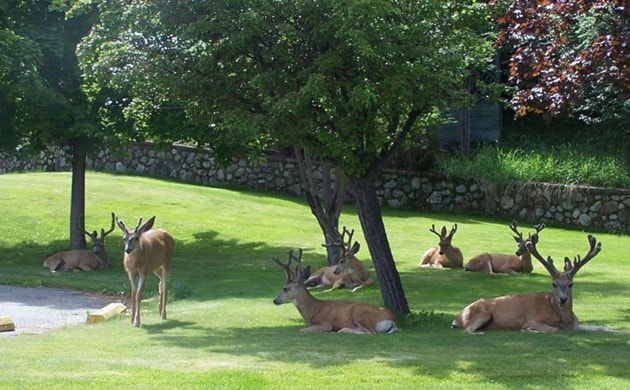Deer counts conducted in Kimberley this past December were down and the population appears to be trending down — for now — says the Kimberley Urban Deer Advisory Committee annual report.
The report was written by KUDAC chair Gary Glinz and received by City Council last week.
“The theme of the report is that we all have a role in managing deer in Kimberley,” said Coun. Darryl Oakley, who sits on the committee. “Education has been very successful and had a big impact. Gary Glinz has determined bylaws are having significant impacts.”
Bylaws include allowing higher fences and the no feeding bylaw.
Oakley says that some of the regular herd in Townsite is being spotted more often on the Lois Creek trails, an indication that they are moving out of town.
The deer counts are not entirely accurate given a number of variables, the report admits,.However, they can give a fairly good indication of the population trend.
“The numbers are lower this year,” Oakley said. “What that’s all about, we’re not sure. Is is new fences? Fences limit the animal’s access to food so they go elsewhere .”
Mayor Don McCormick says the lower numbers are a culmination of all the actions taken since the City began looking at deer population management.
“In the four years since the cull, we’ve put a lot of things in motion,” he said. “Here it is four years later and we are seeing lower numbers. It seems to take a long time, but here we are. But there are new babies each year, so we have to continue what we are doing.”
“Deer counts show that the habituated deer numbers are slowly declining over the last three years,” the report says.”It is difficult to determine all the factors that contributed to this decline. Some of these factors are most likely natural as wild mule deer populations also seem to be declining. The 2015 winter was a relatively mild one with lower snow accumulations, so its curious at to the declining numbers. Outdoor enthusiasts also report seeing more predators around the perimeter trails and town boundaries.
It could also be the mitigation strategies, the city actioned as recommended in “Managing for the Future”, are also beginning to have an impact. Complaints to the city and the COS seem to have increased which could indicate a less tolerance level for habituated deer or more awareness of where to lodge complaints. The data is not definitive. It is important to note that although the strategies seem to be working, habituated deer numbers will eventually increase unless diligent commitment to the recommendations mitigations, including outreach initiatives. This commitment includes the cities willingness to explore other tools to help reduce mule deer populations. This was well demonstrated 2015 by the cities contribution to the deer translocation project.
The report made several recommendations, including continuing support for the translocation trial, continued enforcement of bylaws, continued support for education and continued use of the Managing for the Future document as a guide to controlling deer populations in Kimberley.
